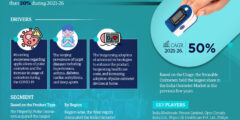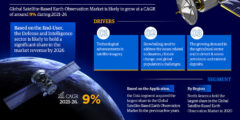Renub Research forecasts that the global organic fertilizer market will attain approximately US$ 20.56 billion through 2030. Organic fertilizers, derived from animal waste, plant debris, and human waste, function as important components for soil microorganism growth. The nutrient density of organic fertilizers depends on their composition. The increasing customer desire for natural goods, driven by fitness attention, propels the burgeoning demand for organic farming. As more individuals choose organic meals because of perceived protection and health benefits, organic agriculture has witnessed a big increase worldwide. Consequently, the marketplace for organic fertilizers experiences a corresponding surge to fulfill the escalating demand in the agricultural area.
With the growing recognition of the harmful consequences of chemical fertilizers, there’s been a tremendous upward thrust in organic fertilizer usage. The increasing preference for natural food drives demand for natural agriculture, fueling the organic fertilizer market. Particularly in Europe, where natural farming is widely spread, the global demand for natural fertilizers is extensive. Europe’s heavy reliance on agriculture similarly boosts demand, expanding the organic fertilizer market.
The global organic fertilizer market valued at US$11.04 billion in 2023, is projected to develop at a CAGR of 9.29% from 2024 to 2030. Increased adoption of natural farming, supported by an emphasis on sustainable agriculture and government backing, drives the increase in the marketplace. However, challenges from climate trade impact crop yields, leading a few farmers to combine natural and chemical fertilizers for better outcomes. Various types of organic fertilizers, inclusive of mineral-organic, pure, microbiological, and bio-organic. Microbiological fertilizers, like the ones from Azotobacter and Rhizobium, improve soil health by solving nitrogen problems and enhancing plant nutrient availability. Governments worldwide are encouraging sustainable agriculture and home production of organic fertilizers through supportive policies, expecting vast market growth.
Request a free sample copy of the report: https://www.renub.com/request-sample-page.php?gturl=organic-fertilizer-market-p.php
The animal segment dominates the market share in the organic fertilizer industry.
Animal-derived sources are at the forefront of the organic fertilizer market, prized for their nutrient-rich composition and soil-enhancing properties. These organic materials, derived from animal waste or by-products, offer a wealth of essential nutrients such as nitrogen, phosphorus, and potassium, vital for plant growth and development. Additionally, they contribute to soil health by improving its structure, moisture retention, and microbial activity, ultimately promoting sustainable agricultural practices. With increasing emphasis on environmentally friendly farming methods and organic produce, the demand for animal-based organic fertilizers continues to surge, driving their dominance in the market landscape.
Soil treatment holds a crucial role in the global organic fertilizer market.
Soil treatment is a key aspect of the organic fertilizer market, commanding a substantial share due to its crucial role in improving soil health and boosting productivity. By addressing soil deficiencies and enhancing nutrient availability, soil treatment methods contribute to healthier plant growth and increased yields. Additionally, these practices promote soil biodiversity, water retention, and overall environmental sustainability. As organic farming practices continue to gain traction worldwide, the demand for soil treatment solutions is expected to rise steadily. Thus, soil treatment remains a fundamental component of organic agriculture, supporting agricultural systems’ long-term viability and resilience.
Microorganisms are crucial in the organic fertilizer market because they are essential to nutrient recycling and soil regeneration.
Microorganisms are essential in the organic fertilizer market, breaking down complex organic compounds in fertilizers, compost, and manure into simpler forms. This process releases vital nutrients like nitrogen, phosphorus, and potassium, which are crucial for plant growth. Additionally, microorganisms enhance soil health by improving its structure, texture, and nutrient retention capacity. They facilitate nutrient cycling and regeneration, maintaining soil fertility in organic farming. Microorganisms contribute to sustainable agricultural practices and environmental stewardship by promoting plant growth and soil fertility. In summary, their role in decomposing organic matter, releasing nutrients, and enhancing soil health makes them indispensable for producing organic fertilizers and ensuring the sustainability and productivity of farming ecosystems.
Cereals and grains hold a significant share in the organic fertilizer market, primarily because of their extensive cultivation worldwide.
Cereals and grains play a significant role in the organic fertilizer market, contributing to sustainable agriculture practices and bolstering food security. As staple crops cultivated extensively across the globe, cereals and grains are vital for meeting the dietary needs of populations worldwide. Using organic fertilizers in their cultivation enhances soil fertility and crop yield, reduces reliance on synthetic chemicals, and promotes environmental sustainability. With growing concerns about food security and the need for eco-friendly agricultural practices, the prominence of cereals and grains in the organic fertilizer market underscores their importance in ensuring a resilient and sustainable food supply chain for future generations.
Dry organic fertilizers are preferred for their reliability, affordability, and compatibility with mechanized farming, making them essential in the market.
Dry fertilizers are extensively utilized in the organic fertilizer market due to their convenience, cost-effectiveness, and ease of application. Farmers can easily store, transport, and apply the product with dry fertilizers without requiring specialized equipment or handling procedures. This makes them a preferred choice for agricultural operations of all scales, from small-scale farms to large commercial enterprises. Additionally, dry fertilizers offer versatility in application methods, allowing farmers to customize their nutrient management strategies according to crop requirements and soil conditions. Overall, the widespread adoption of dry fertilizers underscores their importance in meeting the nutritional needs of crops while promoting sustainable and environmentally friendly agricultural practices.
Asia-Pacific, a key global fertilizer market, ensures food security and sustains global food supplies.
Asia-Pacific’s diverse agricultural landscape and prominent population position it as a crucial global fertilizer market. The region’s varied climates and farming practices generate a strong demand for fertilizers to sustain crop production and food security. Rapid economic growth and urbanization further boost the need for higher agricultural productivity to meet increasing food demands. Consequently, fertilizer manufacturers prioritize the Asia-Pacific market to address these challenges and sustain global food supplies amidst population growth, shifting dietary habits, and climate change.
Key Player
National Fertilizers, Madras Fertilizers, Seek Biotechnology Co. Ltd., Coromandel International, Nagarjuna Fertilizers and Chemicals Ltd., T Stanes & Company Limited, Novozymes, and Kribhco are key players in the worldwide organic fertilizer sector.
Sources – Global Organic Fertilizer Market breakup in 3 viewpoints:
- Plant Based
- Animal Based
- Synthetic Based
Mode of application – Global Organic Fertilizer Market breakup in 3 viewpoints:
- Seed Treatment
- Soil Treatment
- Root Dripping
Product Type – Global Organic Fertilizer Market breakup in Microorganism & Organic Residues and further subdivided into 8 & 4 segments respectively:
- Microorganism
- Azospirillum
- Cyanobacteria
- Phosphate-Solublizing Bacteria
- Azolla
- Aulosira
- Rhizobium
- Azotobacter
- Others
- Organic Residues
- Farm Yard Manure
- Crop Residue
- Green Manure
- Other Products
Crop Type – Global Organic Fertilizer Market breakup in 4 viewpoints:
- Cereals & Grains
- Oilseeds & Pulses
- Fruits & Vegetables
- Others
Form – Global Organic Fertilizer Market breakup in 2 viewpoints:
- Dry
- Liquid
Country – Global Organic Fertilizer Market of 25 Countries covered in the report:
- North America
1.1 United States
1.2 Canada
- Europe
2.1 France
2.2 Germany
2.3 Italy
2.4 Spain
2.5 United Kingdom
2.6 Belgium
2.7 Netherland
2.8 Turkey
- Asia Pacific
3.1 China
3.2 Japan
3.3 India
3.4 South Korea
3.5 Thailand
3.6 Malaysia
3.7 Indonesia
3.8 Australia
3.9 New Zealand
- Latin America
4.1 Brazil
4.2 Mexico
4.3 Argentina
- Middle East & Africa
5.1 South Africa
5.2 Saudi Arabia
5.3 UAE
All the Key players have been covered from 3 Viewpoints:
- Overview
- Recent Development
- Revenue Analysis
Company Analysis:
- National Fertilizers
- Madras Fertilizers
- Seek Biotechnology Co. Ltd,
- Coromandel International
- Nagarujuna fertilizers and Chemicals Ltd,
- T Stanes& Company Limited
- Novozymes
- Kribhco
Browse Related Report:
Agricultural Tractor Market: https://www.renub.com/global-tractor-market-p.php
Europe Fertilizer Market: https://www.renub.com/europe-fertilizer-market-p.php
India Fertilizer Market: https://www.renub.com/india-fertilizers-market-p.php
Specialty Fertilizer Market: https://www.renub.com/specialty-fertilizers-market-p.php
Global Fertilizer Market: https://www.renub.com/global-fertilizer-market-p.php
About the Company:
Renub Research is a Market Research and Information Analysis company with more than 15 years of experience in Research, Survey, and Consulting. Our research helps companies to take business decisions: on strategy, organization, operations, technology, mergers & acquisitions, etc. Till now we have published more than 7000 syndicated reports and worked on more than 500 custom research projects. Currently, we are supplying data to EMIS, Bloomberg, Thomson Reuters, etc. We support many blue-chip companies by providing them with findings and perspectives across a wide range of markets.










